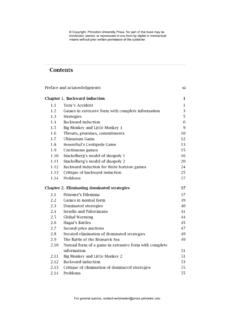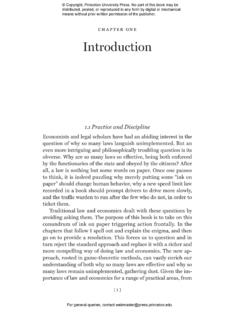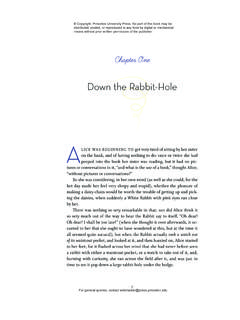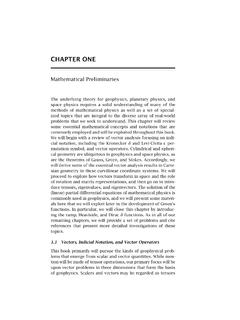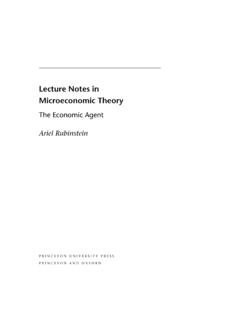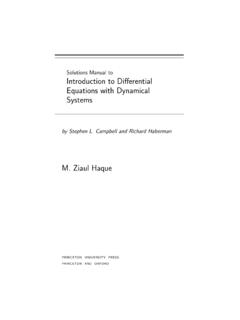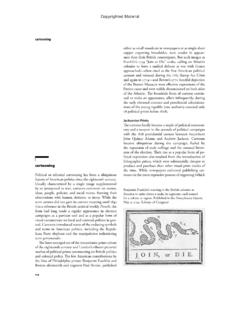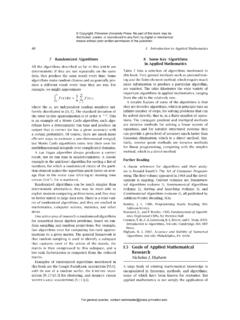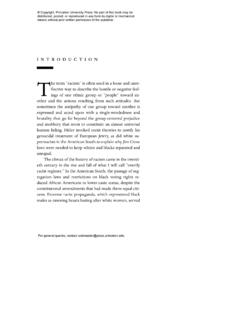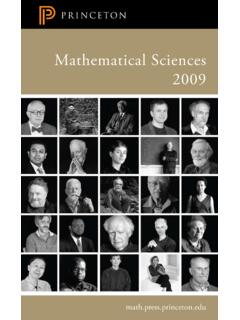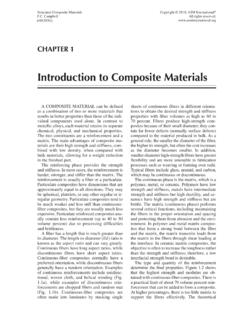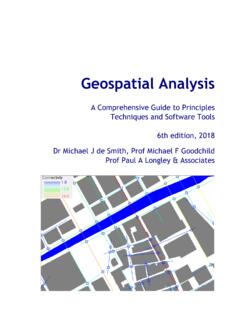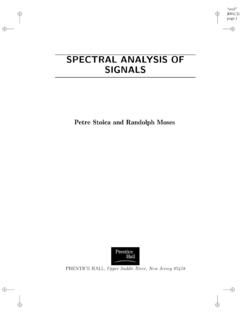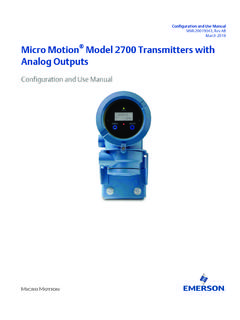Transcription of Transfer Matrix - Princeton University
1 1 Transfer Matrix In this chapter we introduce and discuss a mathematical method for the analysis of the wave propagation in one-dimensional systems. The method uses the Transfer Matrix and is commonly known as the Transfer Matrix method [7,29]. The Transfer Matrix method can be used for the analysis of the wave propagation of quantum particles,suchas electrons[29,46,49,81,82,115 117,124,103,108,131,129,141] andof electromagnetic [39,123,124], acoustic, and elastic waves. Once this techniqueis developed for one type of wave, it can easily be applied to any other wave problem. First we will treat the scattering from an arbitrary one-dimensional potential. Usually, one writes the amplitudes of the waves to the left side of the potential in terms of those on the right side.
2 This defines the Transfer Matrix M. Since we work in a one-dimensional system, the wave in both the left and right sides of the potential has two components, one moving to the right and one moving to the left. Therefore, the Transfer Matrix Mis a 2 2scattering Matrix Swill also be introduced; it describes the outgoing waves in terms of the ingoing waves. The relationship between the Transfer and scattering matrices will be introduced. Time-reversal invariance and conservation of the current density impose strong conditions on the form of the Transfer Matrix M, regardless of the specific form of the potential. Through the Transfer Matrix formalism, the transmission and reflection amplitudes can easily be defined and evaluated. Both traveling and standing (bound) waves will be examined.
3 Once the Transfer Matrix is calculated for one potential, it can be easily extended to calculate analytically the Transfer Matrix for N identical potentials [39, 165]. As the number of potentials increases, the traveling waves give rise to pass bands, while the standing or bound waves give rise to gaps in the energy spectrum of the system. 2 chapter 1 The appearance of bands and gaps is a common characteristic of wave propagation in periodic media. Bands and gaps appear in electronic systems [1,3,4,11,17,23,30], photonic crystals (electromagnetic waves) [33 36,39], phononic crystals (acoustic waves), and left-handed materials. The Transfer Matrix formalism is also very useful in calculating reflection and transmission propertiesof disordered random systems [49,59,89,90,103, 108, 124,129].
4 AScattering Experiment Perhaps the simplest problem in quantum mechanics is the one-dimensional propagation ofan electroninthe presenceofa localized motionofa quantum particleof mass minthe presenceofa potential V(x)in one dimensionis governedbySchr dinger s equation [7,25,30] 2 2W(x) + V(x) E W(x)= 0. ( )2m x2 Here, W(x)isthe wave function and E the energy of the electron. In the absence of a potential, the electron is a wave that travels along in a particular direction. In the presence of a potential, we would like to know how the propagation of the electron changes. Can the electron reflect back? Can the electron pass through the po tential? These questions illustrate some quantum effects not present in classical physics. For simplicity, we assume that the potential V(x)is nonzero only inside a finite region, V(x)for 0 x , V(x)= ( ) 0 for x < 0and x >.
5 An electron approaches the sample represented by the potential V(x)from either the left or the right side of the potential and is scattered by the sample. Scattering means that the electron is either reflected back or transmitted through the sample. We can measure the transmission and reflection amplitudes, t and r, respectively (they will be defined later), and from t and r we can extract information about the physical properties of the sample. We assume that Schr dinger s equation outside the potential region is known and that it can be written as a superposition of plane waves: = W+ L(x)+ W WL(x) L(x), x 0, ( ) WR(x)R(x)+ W R(x), x .= W+ Here,thesubscriptsL(Left)andR(Right) indicatethepositionoftheparticlewithresp ect tothe potential region,andthe superscripts+( ) determinethe directionof propagation: + means that the electron propagates in the positive direction (from left to right) and means that the electron moves from right to left (see figure ).
6 Thus, W+ L(x)isthe wave function of the electron left of the sample, propagating to the right; hence it is approaching the sample. We call W+ L(x)the incident wave, in contrast to W L(x), which is the wave function of the electron propagating away from the sample toward the left side. Transfer Matrix 3 sample + L L + R R W+Figure A typical scattering experiment. Incident waves L(x)and W R(x)are scattered by the sample, characterized by the potential V(x). Outgoing waves W L(x)and W+ R(x)consist of waves transmitted through the sample as well as waves reflected from the sample. Outside the sample, the wave function can be expressed as a superposition of plane waves givenby equations( )and( ). The components of the wave function can be expressed as W+ L(x)= Ae+iqx, W L(x)= Be iqx, ( ) W+ R(x)= Ce+iqx, W R(x)= De iqx.
7 Here, q is the wave vector related to the energy, E of the electron through the dispersion relation E = E(q). ( ) The dispersion relation ( )determines the physical properties of the electron in the region outside the sample(x < 0and x > ). We will call these regions leads. To guarantee the plane wave propagation of the particle, , equation ( ), we require that both leads are translationally invariant. In the simplest cases, we will represent both leads as free space. Then q = kand kis related to the energy of the free particle, 2k2 E = . ( )2m More general realizations of leads, for instance consisting of periodic media, will be discussed later. In this book, we assign k to the free-particle wave vector and use q for more general cases. Scattering Matrix and Transfer Matrix The general solution W(x)of the Schr dinger equation 2 2W(x) + V(x) E W(x)= 0 ( )2m x2 must be a continuous function of the position x.
8 The same must be true for the first derivative W(x)/ x. In particular, the requirement of the continuity of the wave function 4 chapter 1 and its derivative at the boundaries of the potential V(x)gives WL(x = 0 )= U(x = 0+), WL(x) = U(x) ( ) x x x=0 x=0+ on the left boundary of the sample, and WR(x = +)= U(x = ), WR(x) = U(x) ( ) x x x= + x= on the right boundary. Here, U(x)is the solution of Schr dinger s equation inside the potential region0 x . Generally, U(x)cannotbe expressed asa simple superposition of propagating waves. We can, in principle, solve Schr dinger s equation ( )and find explicit expressions for the wave functions for any position x, including the region of the scattering potential. However, this is possible only in very few special cases, since the Schr dinger equation is not analytically solvable for a general form of the potential V(x).
9 In many cases, however, it is sufficient to know only the form of the wave function outside the potential region. This problem is much easier, since the wave function consists only of a superposition of plane waves, as discussed in equations ( )and( ). However, we need to estimate the coefficients A D, defined in equation ( ). This can be done if we know the right-hand sides of the four equations ( )and ( ). Thus, the wave function outside the sample is fully determined by the four parameters that describe the scattering properties of the sample. In general, linear relations between outgoing and incoming waves can be written as W L(x = 0) W+ L(x = 0) = S , ( ) W+ R(x = ) W R(x = ) where the Matrix S, S11 S12 S= , ( ) S21 S22 is called the scattering Matrix .
10 By definition, the Matrix Srelates the outgoing waves to the incoming waves as shown in figure Its elements completely characterize the scattering and transmission properties of the one-dimensional potential V(x). We can also define the Transfer Matrix Mby the relation W+ R(x = ) W+ L(x = 0) = M . ( ) W R(x = ) W L(x = 0) The Matrix Mexpresses the coefficients of the wave function on the right-hand side of the sample in terms of the coefficients of the wave function on the left-hand side. While the representation in terms of the scattering Matrix Scan be easily generalized to three-dimensional systems, the Transfer Matrix approach is more appropriate for the Transfer Matrix 5 analysis of one-dimensional systems and will be used frequently in the following chapters.
